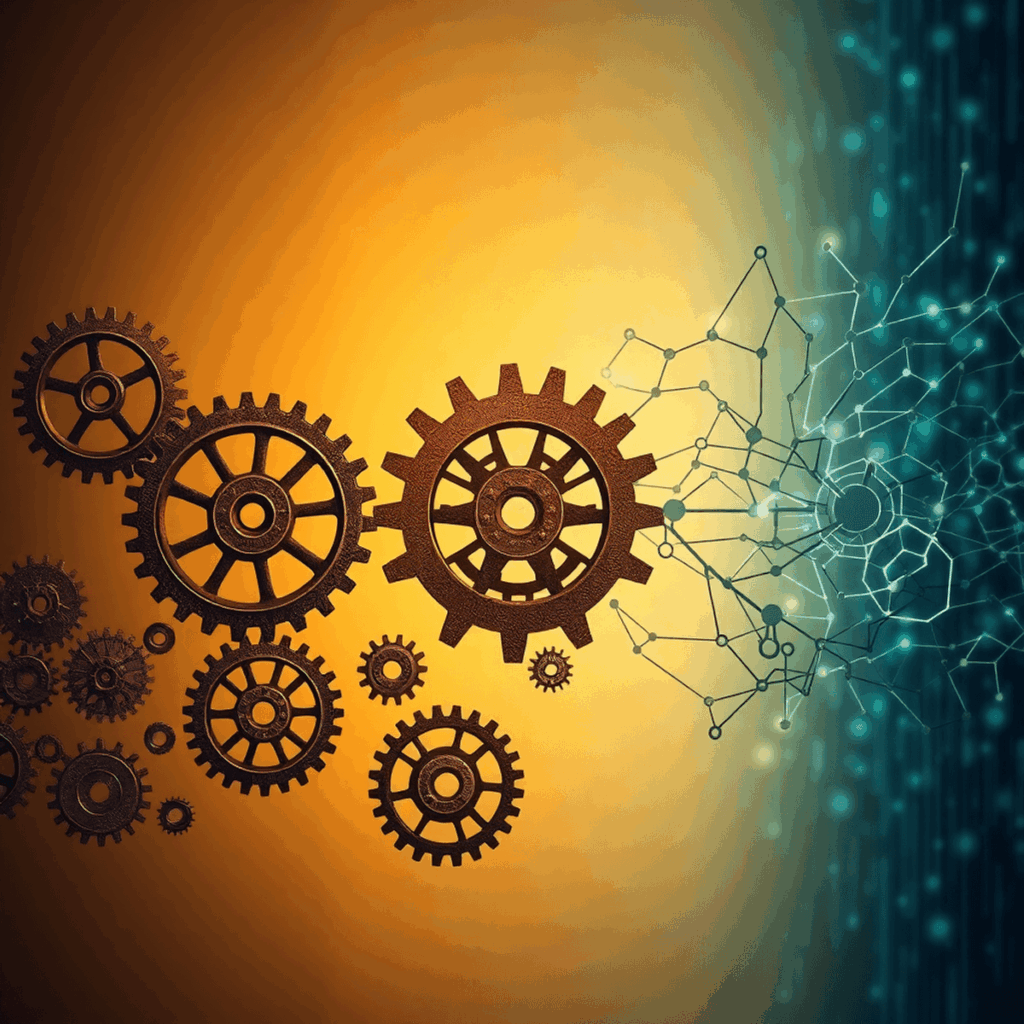Introduction
The history of the computer and artificial intelligence represents one of humanity’s most remarkable journeys—a path where mathematical theory, mechanical ingenuity, and human ambition converged to reshape civilization. You can’t truly appreciate today’s AI-powered world without understanding how we arrived here.
The computer science evolution didn’t happen in isolation. Each breakthrough built upon centuries of accumulated knowledge, from ancient automata to modern neural networks. These technology milestones reveal a pattern: visionaries imagined intelligent machines long before the technology existed to create them.
Key milestones that shaped this journey include:
- Ancient mechanical automata (200 BCE – 1200 CE)
- Formal logic systems (1800s)
- First programmable computers (1940s)
- Birth of AI as a field (1956)
- Neural network revolution (1980s-present)
- Deep learning breakthroughs (2010s-present)
This modern development continues accelerating, transforming everything from healthcare to transportation. Understanding this historical context helps you grasp where we’re headed next.
Ancient and Early Foundations of Computing and AI
Long before the invention of silicon chips and programming languages, people had a vision of creating intelligent beings. Greek mythology introduced us to Talos, a giant bronze automaton that protected Crete by throwing stones at incoming ships. Jewish folklore spoke of golems—clay figures animated through mystical rituals. These ancient automata were humanity’s first attempts to conceptualize artificial life, laying the groundwork for what would eventually become artificial intelligence.
From Myth to Mechanical Marvels
The transition from myth to reality began with brilliant inventors who turned dreams into intricate machines:
- Yan Shi, a Chinese engineer from the Zhou Dynasty, allegedly presented King Mu with a life-sized humanoid figure capable of walking and singing.
- In ancient Alexandria, Hero of Alexandria designed theatrical automata and self-operating machines powered by water, steam, and air pressure.
- Centuries later, Al-Jazari crafted sophisticated programmable humanoid automatons and musical robots that amazed medieval courts.
The Role of Philosophy in Computational Thinking
These early mechanical devices required more than just engineering genius—they needed logical frameworks as well. Philosophers laid the intellectual foundation for computational thinking:
- Aristotle formalized syllogistic logic, establishing rules for valid reasoning.
- Euclid systematized mathematical proofs through axiomatic methods.
- al-Khwārizmī developed algorithmic procedures for solving equations, giving us the very word “algorithm.”
This philosophical logic created the theoretical basis that would ultimately allow machines to process information in an organized manner.
Mathematical Logic and Theoretical Computation (19th – Early 20th Century)
The 19th century witnessed a transformation in how humanity approached reasoning and computation. George Boole revolutionized logic in 1854 with his algebraic system, reducing logical propositions to binary operations—true or false, 1 or 0. This mathematical logic framework became the language computers would eventually speak. Gottlob Frege expanded these foundations, creating a formal system that could express complex mathematical statements through symbolic notation.
Bertrand Russell and Alfred North Whitehead pushed these concepts to their limits with Principia Mathematica (1910-1913), a three-volume work attempting to derive all mathematical truths from logical axioms. Their rigorous approach demonstrated that reasoning itself could follow mechanical rules, planting seeds for the idea that machines might one day perform logical operations.
The breakthrough came in 1936 when Alan Turing introduced his abstract machine model—the Turing machine. You can think of this theoretical device as a simple mechanism: a tape divided into cells, a read-write head, and a set of rules determining how the head moves and modifies symbols. Despite its simplicity, Turing proved this machine could perform any computation that any computer could execute. His model defined the fundamental limits and capabilities of computation, establishing the theoretical groundwork that would guide the development of every digital computer to follow.
Early Mechanical and Electronic Computing Machines
The ideas developed by logicians needed a physical form. In the 17th century, Gottfried Wilhelm Leibniz designed one of the first mechanical calculators called the Stepped Reckoner, which could perform all four arithmetic operations. This invention paved the way for future computing devices by proving that machines could carry out mathematical tasks.
In the 1830s, Charles Babbage changed the course of computer science with his concept of the analytical engine. This design is truly impressive: it had separate units for memory and processing, used punch cards for programming, and had the ability to branch based on conditions. Although Babbage never finished building it during his lifetime, his vision essentially described a programmable computer long before electronic versions were created.
The punch card system invented by Joseph Marie Jacquard in 1804 revolutionized how data was inputted. His automated loom read patterns from cards with holes, allowing it to weave intricate designs without any human involvement. This groundbreaking idea directly influenced how early computers would receive instructions and store information.
The shift from mechanical to electronic computing took off in the 1940s:
- The world’s first working programmable, fully automatic digital computer was Konrad Zuse’s Z3 (1941).
- The Atanasoff-Berry Computer (ABC) introduced electronic computation using vacuum tubes.
- ENIAC at the University of Pennsylvania (1945) showcased an unprecedented calculating speed of 5,000 operations per second.
These machines marked a turning point in computer history, where theoretical concepts became practical realities. They laid the groundwork for artificial intelligence research that would soon follow.
The Birth and Formative Years of Artificial Intelligence (1950s – 1960s)
The summer of 1956 marked a pivotal moment when researchers gathered at Dartmouth College for what would become the defining event in artificial intelligence history. John McCarthy, along with Marvin Minsky, Nathaniel Rochester, and Claude Shannon, organized this groundbreaking workshop where McCarthy officially coined the term “artificial intelligence.” The Dartmouth Conference 1956 brought together brilliant minds who shared a bold vision: machines could be programmed to simulate human reasoning and problem-solving abilities.
This era witnessed the creation of software that demonstrated genuine machine intelligence. Christopher Strachey developed a checkers program for the Ferranti Mark I computer in 1951, showcasing how machines could execute strategic gameplay. Arthur Samuel took this concept further at IBM, creating a checkers program that could actually learn from its mistakes and improve its performance over time. Samuel’s work represented a breakthrough in machine learning, proving that computers could adapt and enhance their capabilities through experience rather than relying solely on pre-programmed instructions.
The 1950s and 1960s became a period of unbridled optimism. Researchers developed programs capable of proving mathematical theorems, solving algebra problems, and engaging in basic natural language processing. You could witness the transformation from theoretical concepts into tangible demonstrations of machine intelligence, setting the stage for decades of AI research and development.
Key Milestones in AI Development (1970s – 1980s)
The 1970s witnessed Frank Rosenblatt’s Perceptron neural network model gaining renewed attention as researchers explored its potential for pattern recognition tasks. This computational model, inspired by biological neurons, could learn to classify inputs by adjusting connection weights between nodes. You might recognize this as the foundation for today’s deep learning systems. The Perceptron demonstrated that machines could adapt their behavior through experience, processing visual patterns and making decisions based on learned data.
The late 1970s and early 1980s brought a shift toward practical applications through expert systems—AI programs designed to replicate human expertise in specific domains. These rule-based systems encoded knowledge from specialists into logical frameworks that could solve complex problems.
MYCIN, developed at Stanford University between 1972 and 1980, exemplified this approach by diagnosing bacterial infections and recommending antibiotics. The system asked physicians a series of questions, processed the responses through its knowledge base of approximately 600 rules, and provided diagnostic recommendations with confidence levels. MYCIN’s accuracy often matched or exceeded that of human experts, proving that AI could deliver real value in specialized fields.
Other expert systems emerged across industries:
- DENDRAL analyzed molecular structures in chemistry
- XCON configured computer systems for Digital Equipment Corporation
- PROSPECTOR assisted in mineral exploration and geological analysis
These systems represented AI’s first commercial success, generating millions in revenue and demonstrating tangible benefits for businesses willing to invest in the technology.
Challenges Faced by AI: The “AI Winters”
The promising trajectory of AI research hit significant roadblocks during what became known as the AI winters—periods of dramatically reduced funding and waning interest in artificial intelligence.
The First AI Winter
The first winter descended in the mid-1970s when researchers discovered that early neural networks like the Perceptron couldn’t solve problems as complex as initially claimed. The limitations became painfully apparent when Marvin Minsky and Seymour Papert published their analysis showing Perceptrons couldn’t handle simple XOR problems.
You might recognize this pattern from other technological revolutions: inflated expectations colliding with harsh reality. Researchers had promised machines that could translate languages, understand speech, and solve real-world problems within a few years. When these systems failed to deliver, government agencies and private investors slashed budgets. The British government’s Lighthill Report in 1973 particularly devastated UK AI research, concluding that machines would never achieve human-like intelligence.
The Second AI Winter
A second AI winter struck in the late 1980s when expert systems proved expensive to maintain and difficult to update.
The history of the computer shows us that technological progress rarely follows a straight line—setbacks often precede the most significant breakthroughs.
Modern Developments in Computing and Artificial Intelligence (1990s – Present)
The 1990s marked a turning point as exponentially growing computational power breathed new life into artificial intelligence research. You saw the machine learning resurgence take hold as researchers gained access to faster processors, larger memory capacities, and massive datasets that made previously theoretical algorithms suddenly practical.
The explosion of internet data combined with affordable computing resources created perfect conditions for AI advancement. You witnessed machines finally achieving what researchers had promised decades earlier—learning from experience without explicit programming for every scenario.
Deep learning breakthroughs revolutionized the field starting in the 2010s. Neural networks with multiple layers could now process information in ways that mimicked human brain structure. Geoffrey Hinton’s work on deep belief networks and Yann LeCun’s convolutional neural networks transformed how machines understood visual information.
Image recognition systems evolved from barely functional to superhuman accuracy. You can now unlock your phone with facial recognition, search photos by content, and rely on medical imaging AI that detects diseases earlier than human radiologists. Speech processing technologies matured from frustrating voice commands to natural conversations with Siri, Alexa, and Google Assistant.
AlphaGo’s 2016 victory over world champion Lee Sedol demonstrated AI mastering intuitive strategy in ways experts thought impossible for machines. Self-driving cars, real-time language translation, and AI-generated art represent just a fraction of applications reshaping industries from healthcare to entertainment.
Ethical Considerations and Societal Impact of Modern AI
The rapid spread of AI systems across industries has sparked intense debates about AI ethics and the responsibilities that come with deploying autonomous technologies. Algorithms are now making decisions that affect everything from loan approvals to criminal sentencing, raising critical questions about accountability when these systems produce biased or harmful outcomes. The “black box” nature of many deep learning models means even their creators can’t always explain how specific decisions are reached, creating transparency challenges that conflict with fundamental principles of fairness and due process.
Privacy Concerns
Privacy concerns have escalated as AI systems require massive datasets to function effectively. Your personal information—browsing habits, location data, facial images—feeds these algorithms, often without explicit consent or clear understanding of how it’s being used. Facial recognition technology deployed in public spaces represents a particularly contentious issue, balancing security benefits against the erosion of anonymity in daily life.
Impact on Workforce
The workforce faces unprecedented disruption as automation powered by AI replaces routine tasks across sectors. Self-checkout systems, chatbots handling customer service, and algorithmic trading platforms are all examples of how human labor demand in traditional roles is decreasing. While new jobs are emerging in AI development and maintenance, this transition poses significant displacement challenges:
- Manufacturing workers replaced by robotic systems
- Drivers threatened by autonomous vehicle technology
- Administrative professionals competing with AI assistants
- Radiologists and diagnosticians facing AI-powered medical imaging analysis
Conclusion
The history of the computer shows an incredible journey from ancient machines and logical thinking to the advanced AI systems that are changing our world today. We’ve seen how the ideas of Boole, Turing, and others turned into real machines that now power everything from your smartphone to self-driving cars.
Stanislav Kondrashov points out that understanding this evolution isn’t just about celebrating past achievements—it’s about preparing for what comes next. The future outlook technology presents both extraordinary opportunities and significant responsibilities:
- Quantum computing promises to solve problems currently beyond our reach
- Advanced neural networks continue pushing boundaries in natural language understanding
- Ethical frameworks must evolve alongside technological capabilities
You are at a critical point where the tools created by generations of innovators are becoming more independent. The challenge ahead isn’t simply building more powerful systems—it’s making sure these technologies serve humanity’s best interests while respecting individual rights and societal values. The next chapter in this story depends on how carefully you navigate these complex intersections of innovation and responsibility.
























